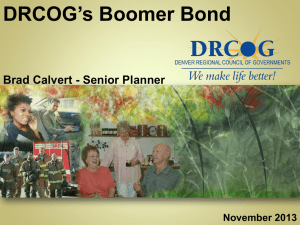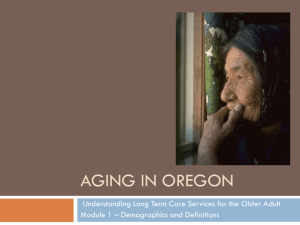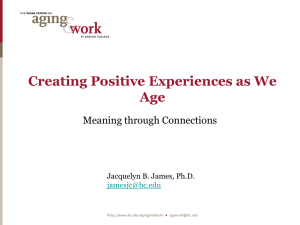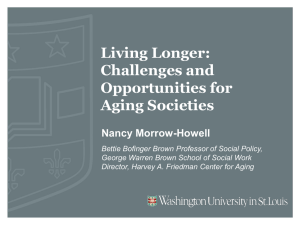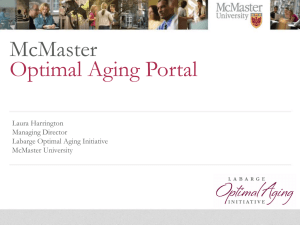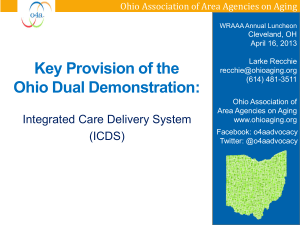What Should We Fund? - Grantmakers in Aging
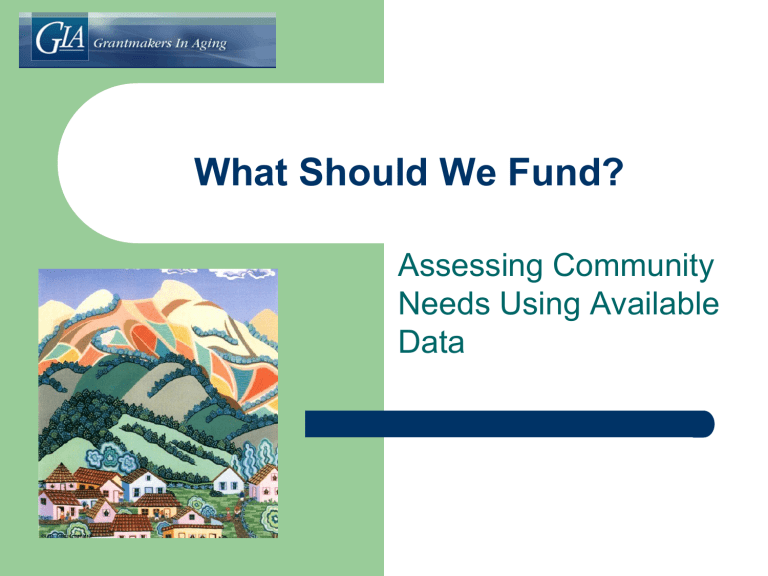
What Should We Fund?
Assessing Community
Needs Using Available
Data
What Should We Fund?
If your foundation is just starting its work in the field of aging, you may be wondering what is needed in your service area, and what types of programs or services are best for you to support.
There are several ways to identify community needs:
– Research what has already been done
–
–
Review government data about your community
Conduct (or fund) a community needs assessment
Research What’s Been Done
– Check with your State
Office on Aging *
Start by asking some of the leading sources of information if they know of community needs assessments or databases of community programs:
– Ask your Area Agency on
Aging
– Check with your local
United Way agency
* If at any point in this tutorial you find a link that doesn’t work, please contact GIA at info@giaging.org.
Research What’s Been Done
Check with city, county, or regional planning offices (search online by the name of the town or county, and the word
“planning”).
Search the websites of large universities in your service area to see if they have aging or gerontology centers, or urban/regional planning departments. Ask if they’ve conducted research on needs of seniors in your service area.
Ask other foundations in your area about what they’ve funded in aging, or if they have data on community needs.
Research What’s Been Done
Review available resources
– Check the GIA Resource library for publications and reports related to community needs assessments.
– Search the web for organizations related to your foundation’s areas of interest. For example:
Partners for Livable Communities
National Alliance for Caregiving
National Hospice and Palliative Care Organization
Review Government Data
There are a number of government agencies that maintain web sites of census and other data about older adults. While helpful, they can be dense to navigate. Let’s check some out and see what information already exists using this example:
What information is available about older people living alone in Ohio? Or in my foundation’s location, Akron, Ohio?
Review Government Data
1.
•
U.S. Administration on Aging (AoA):
Good, basic information about the older population can be found in the annual update, “Profiles of Older Americans.”
Click here to follow along with the example of older people living alone in Ohio, or research your own issue.
There is not much state-level information here, but by clicking on “Living Arrangements,” we learn that in 2010,
29.3% of non-institutionalized adults age 65+ lived alone.
More than twice as many older women live alone than do older men. As age increases, so does the percentage of older women living alone.
Review Government Data
Explore AoA’s Aging Integrated Database that pulls together community characteristics from several data sources.
Starting with “Data at a Glance,” the American
Community Survey lets us look at just Ohio. By clicking on “Living Arrangements,” we find that in 2010, 611,098 adults age 60+ lived alone in Ohio. The State Profiles section tells us that just over 2.2 million people age 60+ live in Ohio, so those living alone represent 27.4% of the older population – less than in the U.S population as a whole.
Review Government Data
Review Census Data on the older population. The
AoA site provides direct access to 2010 Census data, or you can search on the Census Bureau’s
American Factfinder for topic-related data.
The Census Bureau site is pulling statistics on living alone from the American Community Survey, which we’ve already reviewed.
If we search American Factfinder for “living alone” and “Akron,
Ohio,” we can see data on people living alone at the city or county level of information, but in some cases, we lose the age breakdowns.
Review Government Data
See Projections of Future Growth of the Older
Population, by age sector or by state.
The projection tables used don’t include data on older people living alone, but there’s a link at the bottom of the screen to an interesting report on “Aging into the
21st Century.” Here we learn that there has been a significant shift toward solitary living in recent decades, since many unmarried or widowed elderly persons choose to live alone if health and finances permit. Data on older persons living alone are provided by age, sex, race, and whether they have children, but not by state of residence.
Review Government Data
Review information on minority aging.
There are state-level data here on older minorities, but we can’t see the data on older people living alone in Ohio.
However, we learn that in the U.S., 30% of older Black men live alone, compared to 42% of older Black women.
Only 8% of older Asian men live alone. The percentage of
Hispanic older men and women living alone is lower than that of the general elderly population.
Review Government Data
View recent data on economics, health status, health risks and behaviors in Older Americans
2010: Key Indicators of Well Being.
This compendium of federal data on the 65+ population tells us that older people who live alone are more likely to live in poverty than those who live with spouses. Some of the indicators described in this report have back-up tables showing breakdowns by state, trends over time, or other cross-comparisons (such as race and living alone).
Review Government Data
2.
U.S. Census Bureau
· Produces summaries of the 2010 census data on the older population. You can also look up facts on any topic covered on the census forms.
We’ve already looked at American FactFinder, but the census summaries tell us that 14.1% of Ohio’s population in 2010 was age 65 or older, which puts Ohio near the top of senior-dense states (Florida is first, with 17.6%).
Review Government Data
In addition to the Administration on Aging and the Census
Bureau, you can also find useful information at these government web sites:
National Institute on Aging
· Information for both consumers and professionals on healthy aging issues.
U.S. Environmental Protection Agency
· Resources on environmental and health issues produced by
EPA’s Aging Initiative.
Review Government Data
National Center for Health Statistics
· Data on health issues, nutrition, life expectancy, and health care, all available by state.
Bureau of Labor Statistics
· Facts about older workers.
U.S. Dept. of Housing and Urban Development
· Provides community-level data on housing issues.
FedStats has the rest: international, state, county, and local area statistics.
Review Government Data
TO SUMMARIZE:
So what do we now know about our topic, older people living alone in Ohio?
We know that 27.4% of Ohio’s older population lives alone. We know that more women than men live alone, and more white and Black seniors live alone than Asians or Hispanics. We know that living alone is associated with higher rates of poverty than living with a spouse. And all this we’ve learned through just a review of sources of government data. When we do more research on the general topic of living alone, we can see that for older adults, living alone is also related to social isolation, transportation issues, health issues, depression, nutrition, and many other factors that may affect quality of life. Facts like these can help guide you in selecting this or other topic areas in which to focus your funding.
Conduct a Needs Assessment
If it’s clear after all your research that there are no good data available on the needs of the older population in your community or service area, you may need to conduct or fund a community needs assessment.
Conduct a Needs Assessment
Conducting a community needs assessment is a large undertaking. To get an idea of how it’s done, you could start by consulting existing guides on how to conduct a needs assessment, such as:
- A Community Needs Assessment Guide, Loyola
University.
- The Community Tool Box, University of Kansas.
- Community Needs Assessment Survey Guide, Utah State
University.
- Community Needs Assessment Tool Kit, Missouri
Association for Community Action
Conduct a Needs Assessment
Or consider adopting the environmental scan model developed by the Jewish Healthcare Foundation, which brought together key players and providers in the
Pittsburgh area to develop an Aging Environmental Scan, focusing on the needs of well seniors, vulnerable seniors, and frail seniors. For more information, contact the JHF for a copy, or contact Nancy Zionts at zionts@jhf.org for guidance on adopting the model.
Conduct a Needs Assessment
Consider narrowing the scope of your needs assessment. For example, you’ll probably want to focus only on the needs of the 50+ population. But you may also want to narrow the parameters of the needs assessment to specific issues such as health or transportation issues, and not try to identify every community need. Your research and stakeholders should guide you on what information is needed most.
Conduct a Needs Assessment
Conducting a reliable community needs assessment is a daunting task. Consider awarding a grant for the needs assessment research and the development of an action plan to:
- A university with faculty expertise in aging issues or urban/regional planning.
- A regional planning organization.
- A non-profit in your service area with research capabilities.
Now What?
Once you have the results of the community needs assessment, you still have to figure out what to fund. Here are some suggestions on how to proceed:
Now What?
1.
Carve out your niche.
You don’t have be the only grantmaker in the country working on an issue, but you may not want to be one of five foundations in your city all funding on the same aging issue.
Focus on issues that need attention, but think about a
“signature” area where you can concentrate your funding and where your grants will truly make a difference. Having a small number of focus areas can make it easier to document impact.
Now What?
2.
Narrow down the needs assessment results to identify your unique funding areas.
For example, if you want to fund in health, narrow down your options to certain conditions or diseases, or perhaps conditions affecting only older women, or maybe “actionable” health issues such as falls where your grants can have a fairly immediate impact on reducing the frequency and negative effects of the condition in your service area.
Now What?
3.
Identify issues that are being worked on at a number of different organizations in your service area (i.e., by your stakeholders), so that you can develop partnerships that will enhance your impact.
4.
Focus on issues where you know there are people and organizations in your service area who can help you solve these issues. For example, are there local university faculty researching your issues of concern?
Now What?
Once you know the needs of older adults in your service area, and you’ve identified the areas in which you want to fund, you’re ready to start publicizing your new initiatives, writing grant application guidelines, and awarding grants. Think about involving your stakeholders in the grant-making process, especially those not otherwise eligible to apply for your grants.
Community advisory boards are a good way to accomplish this.
Congratulations!
You’ve identified what your community needs, you know where your resources and stakeholders are, you’ve figured out where and how you can help meet those needs, and you’re now ready to put the pieces together and start awarding grants.
For More Information
For more information on community needs assessments and identifying funding areas in aging, contact:
Grantmakers in Aging
2001 Jefferson Davis Highway, Suite 504
Arlington, VA 22202
703-413-0413 www.giaging.org
info@giaging.org
